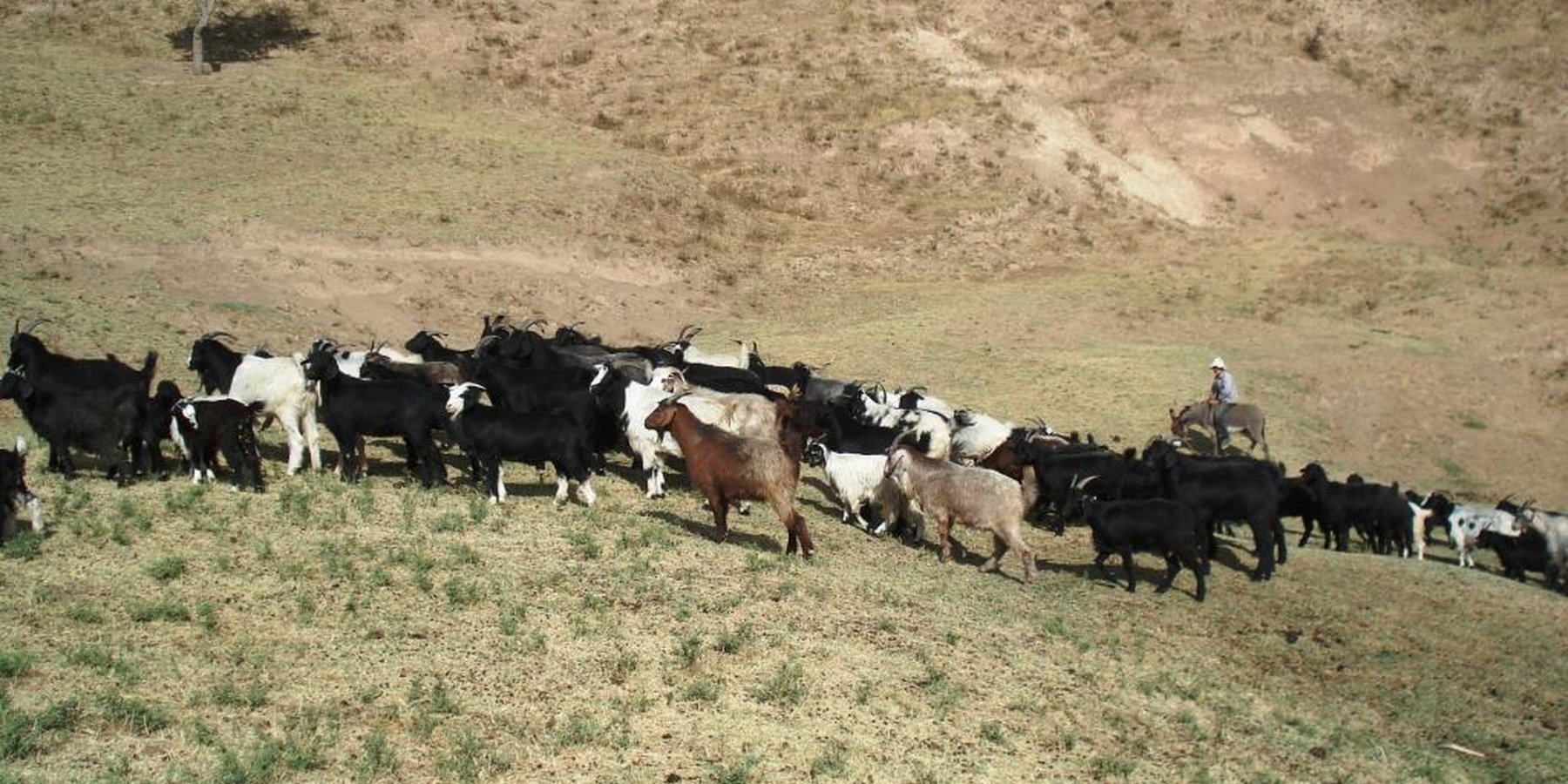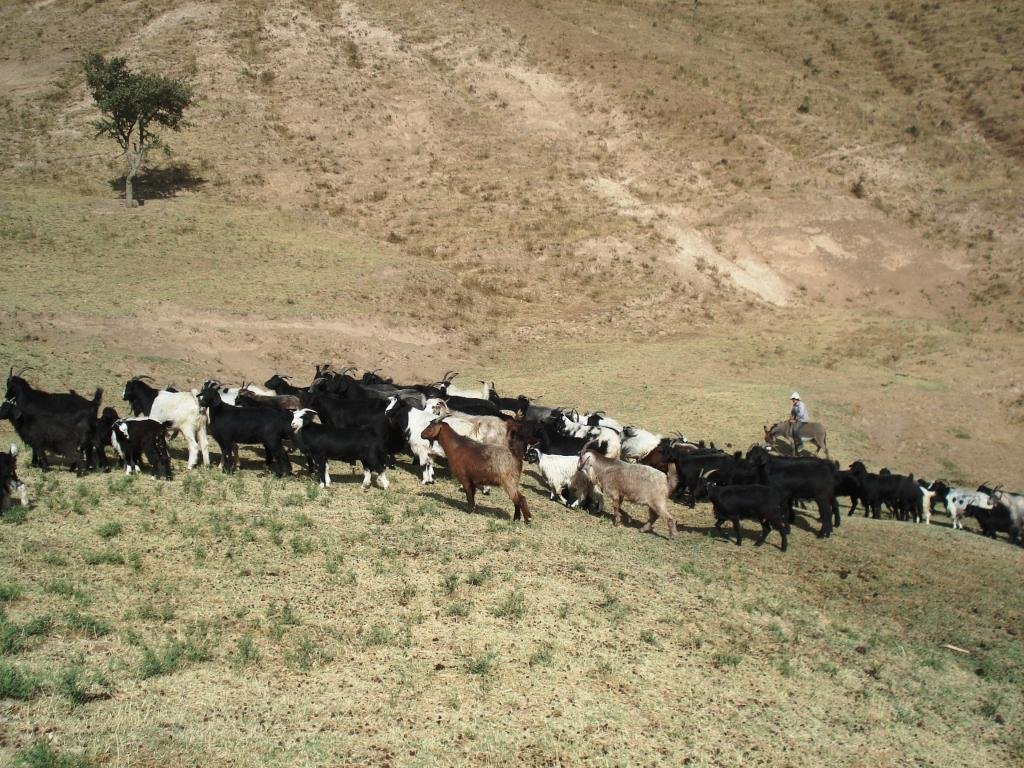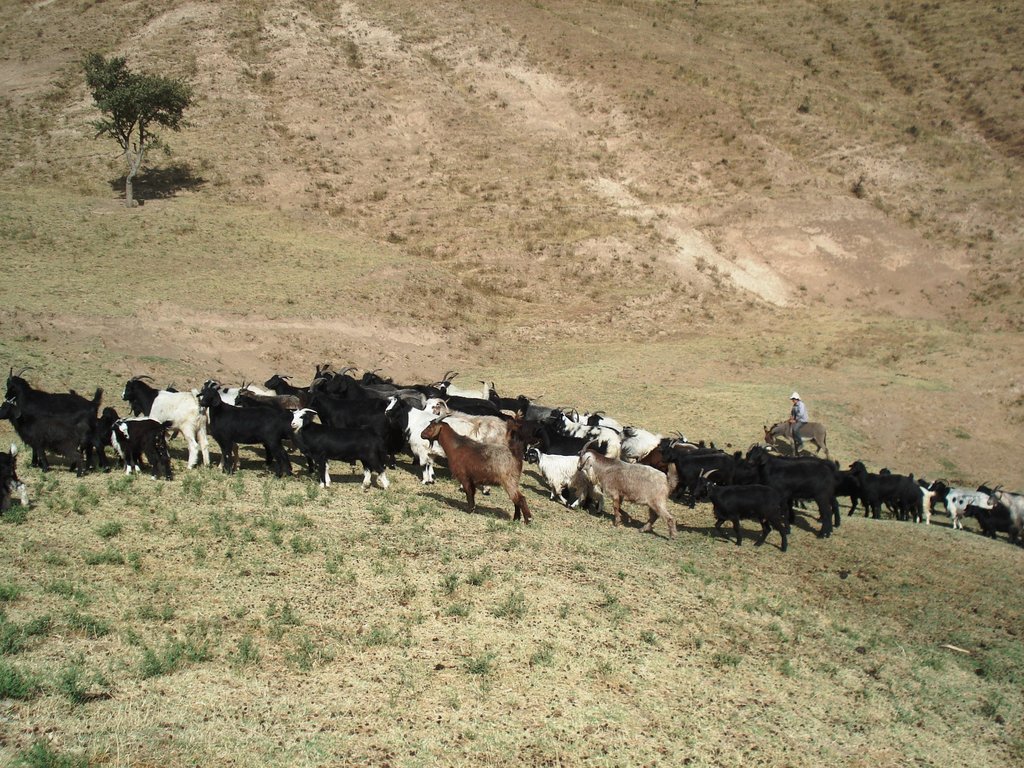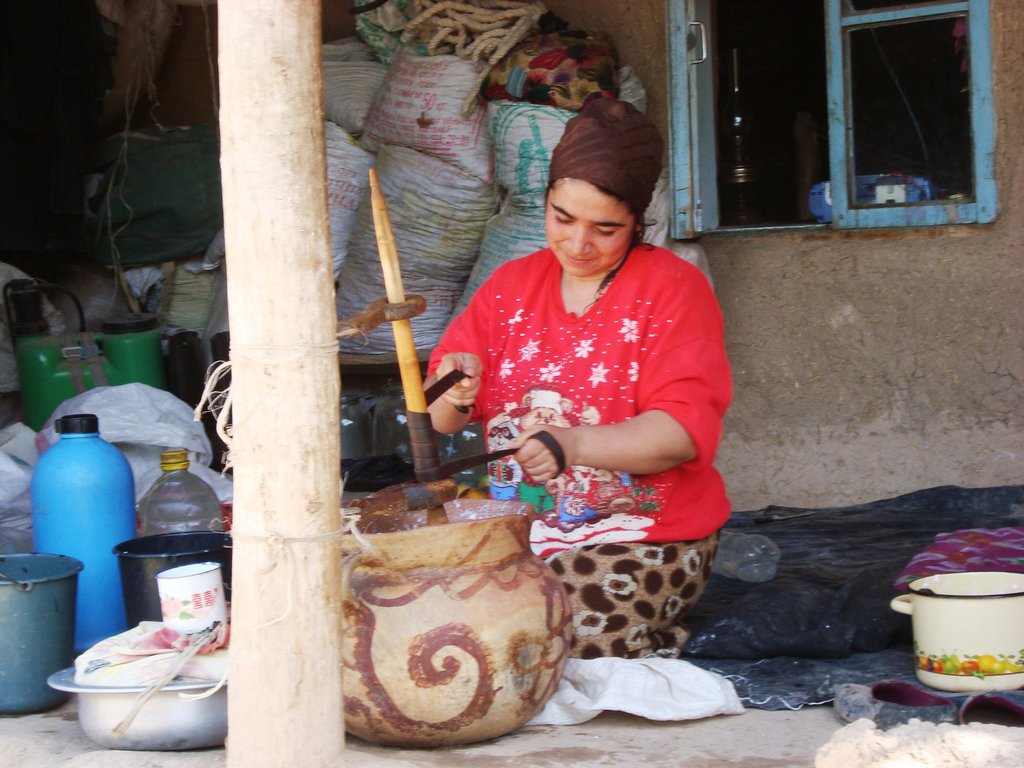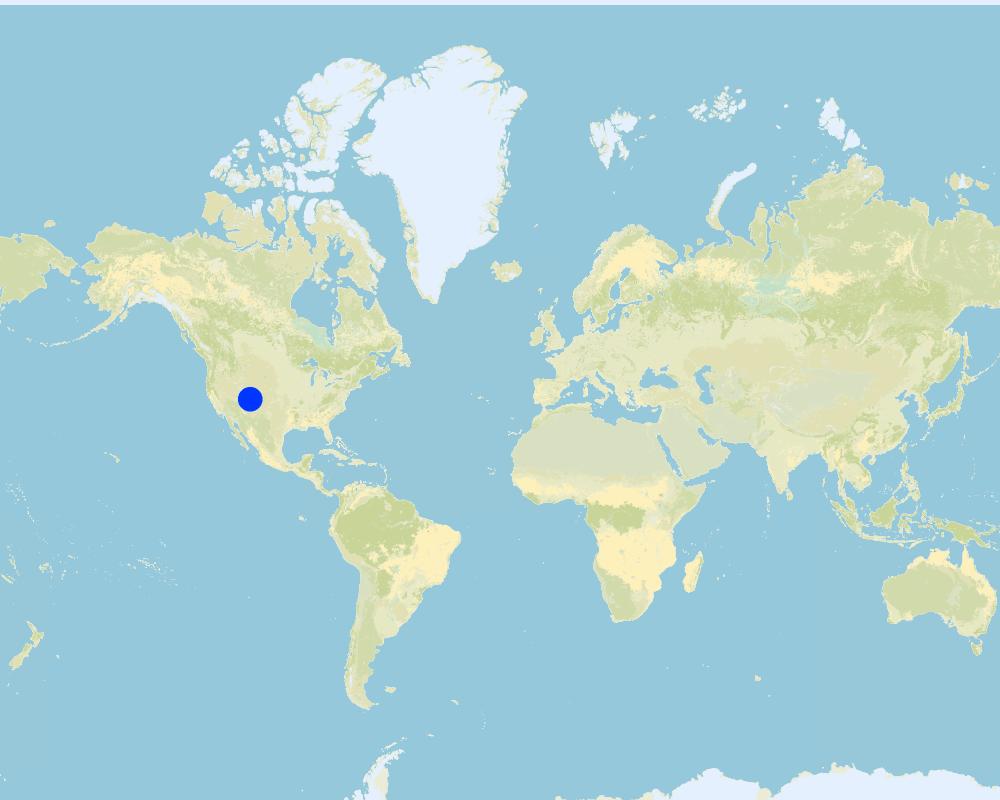Family-based daily herding [Tajikistan]
- Creation:
- Update:
- Compiler: Christian Wirz
- Editor: –
- Reviewer: David Streiff
approaches_2657 - Tajikistan
View sections
Expand all Collapse all1. General information
1.2 Contact details of resource persons and institutions involved in the assessment and documentation of the Approach
Name of the institution(s) which facilitated the documentation/ evaluation of the Approach (if relevant)
CDE Centre for Development and Environment (CDE Centre for Development and Environment) - Switzerland1.3 Conditions regarding the use of data documented through WOCAT
When were the data compiled (in the field)?
20/08/2008
The compiler and key resource person(s) accept the conditions regarding the use of data documented through WOCAT:
Ja
1.4 Reference(s) to Questionnaire(s) on SLM Technologies
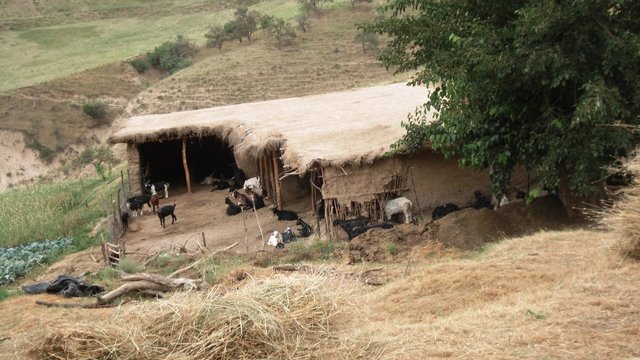
Reduced livestock numbers [Tajikistan]
The grasslands are used as pastures by a reduced number of livestock belonging to an individual land user.
- Compiler: Christian Wirz
2. Description of the SLM Approach
2.1 Short description of the Approach
Private herding of 50 goats by the land user and his sons.
2.2 Detailed description of the Approach
Detailed description of the Approach:
Aims / objectives: The most important objective for the land user is to make a living for his family (himself, his wife, his sons and their families) by means of simple work, without taking money from others that does not belong to him (without taking bribes). Animal husbandry is an important part of his multistrategy (orchard, kitchen garden, haymaking, grazing). He wants his animals to be fat and healthy and measures the success of his work by the prices obtained on the cattle-market. Further, he does not want that animals damage pastures by too high numbers or too early grazing. For example, vegetation cover is important for him, because it is a protection of soils against frost, it is the best reservoir of seeds and it provides dung for oither plants
Methods: The most important method is is the land user's own initiative, since administration reveals to be a handicap rather than a help. The land user understands himself as someone who relfects on problems and searches for solutions. As an example he mentions the visible damages caused especially by cows if they are led to the pastures too early. He does not lead his cows to the pastures before May because of this and he recommends the village to do so, too, for the village herds. For him, it is necessary to learn from the environment and to respect it. He is also convinced that in the new economic reality after the breakdown of Soviet Union, initiative and entrepreneurial spirit are necessary for success.
Stages of implementation: After renting land for the implementation of an orchard, building a hut and cultivating a garden, he bought a herd. This means that for him breakdown of USSR marks the beginning of his 'Self-made man' approach.
Role of stakeholders: Every family member should contribute to the success of the family enterprise.
2.3 Photos of the Approach
2.5 Country/ region/ locations where the Approach has been applied
Country:
Tajikistan
Region/ State/ Province:
Region of Republican Subordination
Further specification of location:
Faizabad
Map
×2.6 Dates of initiation and termination of the Approach
Indicate year of initiation:
1991
2.7 Type of Approach
- recent local initiative/ innovative
2.8 Main aims/ objectives of the Approach
The Approach focused mainly on other activities than SLM (Assuring livestock nutrition, minimising labour input for herding. Still, conservation is also important.)
The choice to have an own herd, separated from the village herd and with the daily obligation to send a family member for herding is mainly based on productivity and animal health: Besides having fatter animals on these more distant pastures it permits the land user to keep billy goats separately from the females to avoid having goatlets before the middle of March. This is important as the goatlets might die because of the low temperatures. In village herds animals always stay together. In addition pastures in the hills around his land are better than those close to villages.
The SLM Approach addressed the following problems: Especially during civil war the main challenge was survival. This means, that in insecure times (that still continue to a certain degree) it was necessary to escape the chaos of war, which was best possible by this self-sufficient system.
2.9 Conditions enabling or hindering implementation of the Technology/ Technologies applied under the Approach
social/ cultural/ religious norms and values
- hindering
Jealousy of some villagers led to burning down a part of his orchard.
Treatment through the SLM Approach: Trees were planted again. Since then, nothing happened anymore.
legal framework (land tenure, land and water use rights)
- hindering
Even if he has a farmer's association with land that he can cultivate autonomously, administration regularly asked him for money to have clear land tenure.
Treatment through the SLM Approach: Paying for ones rights is unavoidable.
The existing land ownership, land use rights / water rights moderately hindered the approach implementation Even if the land reforms after independance made it possible to build up a farmer's association and to rent land, its slow implementation and the partly unclear land tenure make it difficult to plan business. For example, planting trees for rehabilitation would require the security that the returns by improved pastures would profit the land user. As a further example, the land user would have liked to start a factory with mineral water, but his rights for the use of water are unclear and he is
3. Participation and roles of stakeholders involved
3.1 Stakeholders involved in the Approach and their roles
- local land users/ local communities
The land user with his family
Traditionally, herding is a matter of men, whereas the work in the kitchen, together with the production of butter, cream and curd cheese is done by women.
3.2 Involvement of local land users/ local communities in the different phases of the Approach
| Involvement of local land users/ local communities | Specify who was involved and describe activities | |
|---|---|---|
| initiation/ motivation | self-mobilization | |
| planning | self-mobilization | |
| implementation | self-mobilization | |
| monitoring/ evaluation | none | |
| Research | none |
3.4 Decision-making on the selection of SLM Technology/ Technologies
Specify who decided on the selection of the Technology/ Technologies to be implemented:
- land users alone (self-initiative)
Explain:
The land user bought the land and built up his own livelihood by himself, together with his family.
Decisions on the method of implementing the SLM Technology were made by by land users* alone (self-initiative / bottom-up). Even if in the beginning Soil Institute was interested in research activities on his land, this did not take place, so that he bases all his decisions on his own knowledge and experience.
4. Technical support, capacity building, and knowledge management
4.1 Capacity building/ training
Was training provided to land users/ other stakeholders?
Nee
4.2 Advisory service
Do land users have access to an advisory service?
Nee
4.4 Monitoring and evaluation
Is monitoring and evaluation part of the Approach?
Ja
Comments:
bio-physical aspects were ad hoc monitored by land users through observations; indicators: Moisture of vegetation, signs of erosion.
There were no changes in the Approach as a result of monitoring and evaluation: None
There were no changes in the Technology as a result of monitoring and evaluation: None
4.5 Research
Was research part of the Approach?
Nee
5. Financing and external material support
5.1 Annual budget for the SLM component of the Approach
If precise annual budget is not known, indicate range:
- < 2,000
Comments (e.g. main sources of funding/ major donors):
Approach costs were met by the following donors: local community / land user(s): 100.0%
5.2 Financial/ material support provided to land users
Did land users receive financial/ material support for implementing the Technology/ Technologies?
Nee
5.3 Subsidies for specific inputs (including labour)
If labour by land users was a substantial input, was it:
- voluntary
Comments:
Herding is not rewarded by anyone (voluntary labour).
5.4 Credit
Was credit provided under the Approach for SLM activities?
Nee
6. Impact analysis and concluding statements
6.1 Impacts of the Approach
Did the Approach help land users to implement and maintain SLM Technologies?
- No
- Yes, little
- Yes, moderately
- Yes, greatly
It helped in the sense of allowing the land user to develop and implement a herding system by himself. It only helped little because the main reason for having less erosion than in other places is the lower accessibility.
Did the Approach empower socially and economically disadvantaged groups?
- No
- Yes, little
- Yes, moderately
- Yes, greatly
Did the Approach improve issues of land tenure/ user rights that hindered implementation of SLM Technologies?
- No
- Yes, little
- Yes, moderately
- Yes, greatly
The fact of being able to graze only slightly used village pastures without paying additional rent fees is positive.
Did other land users / projects adopt the Approach?
- No
- Yes, little
- Yes, moderately
- Yes, greatly
The land user did not mention anyone else with a similar herding system. It might only make sense to have an own herd daily grazing in a more or less fix area under the circumstances given: low accessibility for the village herd and a completely self-sufficient family-enterprise.
Did the Approach lead to improved livelihoods / human well-being?
- No
- Yes, little
- Yes, moderately
- Yes, greatly
The prices achieved by this land user for a sold animal are far higher than those for an average animal of a village herd. And the animals are fatter, thus providing for more food. At the same time th
Did the Approach help to alleviate poverty?
- No
- Yes, little
- Yes, moderately
- Yes, greatly
The land user was already well-situated in Soviet times, so the additional wealth is negligible.
6.2 Main motivation of land users to implement SLM
- increased profit(ability), improved cost-benefit-ratio
This method allows high returns (fat animals) with minimal costs.
- prestige, social pressure/ social cohesion
A humble man works much to leave his children remaining values, i.e. good pastures.
6.3 Sustainability of Approach activities
Can the land users sustain what has been implemented through the Approach (without external support)?
- yes
6.4 Strengths/ advantages of the Approach
| Strengths/ advantages/ opportunities in the land user’s view |
|---|
| Having land that he can use alone (only garden and orchard) or at least quite independently (pastures) is an advantage for him. (How to sustain/ enhance this strength: Giving him the right to use the pastures as a part of his farmer's association would be an interesting option for him.) |
| Because his approach is based on observations, the land user has a good knowledge of the state of environment and especially of livestock. |
| There is a potential of more fodder-production (esparset, lucerne) thanks to the rented land. (How to sustain/ enhance this strength: This might enable him to keep more animals, which is his objective.) |
| Strengths/ advantages/ opportunities in the compiler’s or other key resource person’s view |
|---|
| It combines a reasonable use of available workforce with minimal labour inputs, for instance by leaving the cows on the pastures without a herder. (How to sustain/ enhance this strength: Continuity is given thanks to both sons' decision to continue the project of their father with their families) |
| It is based on the reflected, autonomous decisions of a land user with a good education. (How to sustain/ enhance this strength: Education of sons and grandchildren is important for the land user.) |
6.5 Weaknesses/ disadvantages of the Approach and ways of overcoming them
| Weaknesses/ disadvantages/ risks in the compiler’s or other key resource person’s view | How can they be overcome? |
|---|---|
| No systematical monitoring and no research on the efficiency of this herding system are carried out on the land user's land. | Collaboration with the soil institute might be interesting and might be facilitated by the land user's past function as research coordinator of this institute . |
| No clear land use rights and charges defined in a possibly new legal situation (semiprivate use of pastures). | Land reforms must define if and under which conditions pastures can be rented by privates. |
| No research or systematical monitoring exist in the study-area for this herding system | Collaboration with soil institute, whose former brigadier the land user was. |
Links and modules
Expand all Collapse allLinks

Reduced livestock numbers [Tajikistan]
The grasslands are used as pastures by a reduced number of livestock belonging to an individual land user.
- Compiler: Christian Wirz
Modules
No modules


